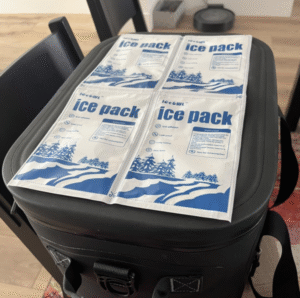How to Pack Using Dry Ice Safely in 2025?
If you need a clear, proven method for how to pack using dry ice, this guide gives you the exact steps, sizing rules, and compliance checks you can trust. You’ll learn fast, safe packouts, an easy sizing formula, et 2025 airline and ground‑shipping requirements, so your frozen and chilled products arrive intact and on time.
-
How to pack using dry ice with a simple, step‑by‑step workflow
-
How to size dry ice for 24–72 hours with a quick calculator
-
How to pack using dry ice for flights and UN1845 ground shipping
-
How to combine dry ice with gel/regular ice without damaging goods
-
How to reduce risk (burns, Accumulation de co₂) with fast safety checks
Why choose dry ice—and how to pack using dry ice for your product?
Dry ice gives you deep‑freeze power without meltwater, but your packout must vent CO₂ and protect items from direct contact. In practice, you’ll build layers that control airflow and temperature while preventing pressure buildup. Use a rigid, dry‑ice‑rated container and keep the package ventilé—never gas‑tight.
From your point of view: start with your product goal. If you must keep items frozen, use larger blocks and tighter fill. If you only need chilled temperatures, use less dry ice and buffer with gel packs. Either way, choose a container rated for dry ice and plan for minimal lid openings during transit.
Frozen vs. chilled: where do you place the dry ice?
For frozen holds: place blocks above and/or below the load with a séparateur (cardboard/wire rack) to avoid direct contact; top placement leverages cold air sinking, bottom placement stabilizes the base—many packouts use both.
For gentle chilling: confine a small block to one corner under a separator and rely on gel packs to moderate cold shock.
| Packout Goal | Placement | Ice Type | Ce que cela signifie pour vous |
|---|---|---|---|
| Solid frozen | Haut + bottom (with separators) | Blocks (durer plus longtemps) | Faster pull‑down, longer runtime, even temps |
| Mixed load | Dry ice bottom + gel mid‑layer | Blocks + gel | Frozen zone + chilled zone in one box |
| Chilled only | Small “corner” block + many gels | Small block + gels | Prevents freezing sensitive items |
How to pack using dry ice: the step‑by‑step checklist
Core sequence: gloves on → pre‑chill → create base → place blocks → add separator → load product → fill voids → vent → monitor. Follow this order to protect the container, avoid cold burns, and maintain stable temperatures.
Step‑by‑step (copy/paste ready):
-
Confirm compatibility. Use a rigid, dry‑ice‑rated cooler/shipper; most soft coolers are not rated.
-
Pre‑chill. Cool the container and contents before loading.
-
Wear PPE. Insulated gloves; eye protection if cutting blocks.
-
Create a base. Corrugated cardboard or a rack to lift product off blocks.
-
Place dry ice. Prefer blocks for longevity; wrap in paper to slow sublimation.
-
Add a separator. Cardboard/towel/wire basket between ice and product.
-
Pack tight. Fill voids with towels or gel packs; puits d'air froid.
-
Allow venting. Never seal gas‑tight; crack a latch or use a vented drain.
-
Monitor. Use a probe or min/max thermometer inside the load.
Quick sizing: how to pack using dry ice for 24–72 hours
Rules of thumb:
-
Frozen hold: ~10–15 lb per 25 qt per 24 h
-
Chilled hold: ~5–10 lb per 25 qt per 24 h
Blocks last longer than pellets; hot weather and frequent openings increase needs.
Spreadsheet‑ready estimator (paste & adapt):
-
GoalFactor: 1.0–1.5 (chilled) or 2.0–2.5 (frozen)
-
ConditionsFactor: 0.8 (cold/shade), 1.0 (normal), 1.3–1.5 (hot/sunny)
| Taille plus froide & Goal | 24 h | 48 h | Ce que cela signifie pour vous |
|---|---|---|---|
| 25 QT (frozen) | 10–15 lb | 20–25 lb | Weekend freeze performance |
| 50 QT (frozen) | 20–30 lb | 40–50 lb | Family/meat run |
| 25–50 qt (chilled) | 5–10 lb | 10–20 lb | Drinks/dairy ≤40°F |
Pro tip: Split frequent‑access items into a second “day‑use” cooler to protect the main frozen reserve.
How to pack using dry ice for flights and travel?
You can fly with dry ice under strict limits: ≤2.5 kg (5.5 kg) per passenger and per package, operator approval, emballage ventilé, et markings (“Dry ice / Carbon dioxide, solide,» UN1845, masse nette). Always confirm your airline’s policy before travel.
Airport packout checklist:
-
Utiliser un vented hard cooler (no sealed styro lids).
-
Label: “Dry ice / Carbon dioxide, solide,» UN1845, masse nette (kg).
-
Keep the lid latched but pas gas‑tight; maintain venting.
-
Carry airline approval details with your bag.
Cas réel: A bakery shipped frozen croissants cross‑country with 20 kg dans un 40 QT cooler plus a wire shelf. Après 30 heures dans 84–95°F ambient, internal product temperatures stayed below 15°F, confirming an intact frozen chain.
How to pack using dry ice for ground shipping (UN1845)?
For road parcels in the U.S., dry ice is “Carbon dioxide, solide,” UN1845, Classe 9. Packages must vent CO₂ and be marked with the net mass of dry ice; use rigid outer boxes. When air segments are possible, small quantities ≤2.5 kg per package with required markings are excepted from many other requirements.
Compliance quick‑check (printable):
-
Marque UN1845, Nom d'expédition approprié, et masse nette
-
Utiliser ventilé conditionnement; never gas‑tight
-
Utiliser un rigid outer box; add absorbent if liquids are present
-
Include a simple content description per carrier policy
How to pack using dry ice with gel packs or regular ice?
Mixing works—and often works best. Put dry ice beneath a separator to chill from below, alors gel packs on top to buffer items that shouldn’t freeze. This creates frozen and chilled zones in one container and extends runtime significantly.
Practical setups (fast wins)
-
All frozen: blocks at top et bottom, separators between layers
-
Frozen + chilled: dry ice bottom → separator → product → gels on top
-
Chilled only: small “corner” block + many gels for gentle cold
Safety first: how to pack using dry ice without risk?
Two hazards dominate: extreme cold and CO₂ buildup. Wear insulated gloves, work in ventilated areas, et jamais make packages airtight. Keep chilled foods ≤40°F (4°C) and use a thermometer or data logger to verify performance. Don’t trap a venting cooler in a sealed car trunk.
User tips you can apply today
-
Loading at home: Use a probe thermometer and record min/max after arrival.
-
Summer route: Shade the cooler and limit lid opens; heat spikes are cumulative.
-
Team handoff: Add a one‑page “re‑ice or not” instruction with the net mass marked.
Field example: A 50‑qt rotomolded cooler with 25 kg of blocks held below 10°F for ~40 heures on a 92°F day with 8–10 lid opens, rising to ~28°F by hour ~52. Results vary by insulation and sun.
2025 developments and trends in how to pack using dry ice
Trend snapshot (2025): Dry ice demand stays high across food, Pharma, and e‑commerce, alors que CO₂ supply volatility creates seasonal price spikes. Reusable shippers et PCM systems are scaling for 2–8°C and –20°C lanes, reducing dry‑ice reliance where deep‑freeze isn’t required. On‑site pelletizers are growing to derisk supply.
Latest progress at a glance
-
Air travel clarity: FAA PackSafe guidance reinforces the 2.5 kg limit and clear marking rules; most airlines mirror it.
-
PHMSA summaries: Refocus on ventilation et masse nette marking for UN1845 packages.
-
Food safety signal: Agencies reiterate the ≤40°F cold‑holding threshold; use appliance thermometers.
Perspicacité du marché: Expect continued growth through 2032 as blasting, Pharma, and perishables expand; supply remains regional—plan local sourcing et contingencies.
FAQ
How much dry ice per day do I need?
Plan ~10–15 lb per 25 QT par 24 h for frozen, ~5–10 lb for chilled. Upsize in hot weather or with frequent lid opens.
Can I fly with it?
Oui-≤2.5 kg (5.5 kg) per passenger and per package, airline approval, emballage ventilé, and proper markings.
Will dry ice damage my cooler?
Only if it’s not rated. Many hard coolers allow dry ice; soft coolers often do not—check manufacturer guidance.
Should I place dry ice on top or bottom?
Utiliser haut to leverage cold air sinking; use bottom with a separator to shield items and stabilize the base. Mixed placements are common for even temps.
What’s the foodsafe cold threshold?
Keep chilled foods ≤40°F (4°C); verify with a thermometer or logger inside the load.
Résumé & recommendations
Points clés: How to pack using dry ice comes down to rated containers, blocks + séparateur + tight fill + ventilation, and realistic sizing. Verify airline/PHMSA rules when you travel or ship, and keep chilled foods ≤40°F with an internal probe. Pour les charges mixtes, combine dry ice and gel packs to create frozen and chilled zones.
Étapes suivantes (action plan):
-
Confirm your container is dry‑ice rated.
-
Use the estimator to size blocks for your route.
-
Pack in layers with separators; fill voids tightly.
-
Secouer at all times and add a thermometer/logger.
-
For complex routes, request a validated packout from Tempk.
À propos du tempk
We blend cold‑chain engineering with route testing to design data‑driven packouts and calculators for perishable food, biopharma, and specialty goods. Our team tracks FAA/PHMSA updates and brand‑specific container guidance so you get current, pratique instructions that cut spoilage and compliance risk. Talk to us for a tailored plan.
























